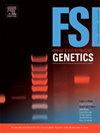Searching national DNA databases with complex DNA profiles: An empirical study using probabilistic genotyping
IF 3.2
2区 医学
Q2 GENETICS & HEREDITY
引用次数: 0
Abstract
In most National DNA databases (NDNADB), only single source DNA profiles, and sometimes two-person DNA mixtures, can be searched provided a minimum number of loci (or alleles) is available. DNA profiles that do not meet these criteria (about 14 % of the traces analyzed in Western Switzerland) can be compared locally with candidates upon request from police services, used for one-off search, or remain unused. With the advent of probabilistic genotyping (PG), such complex DNA profiles can be compared to those stored in NDNADB based on likelihood ratios (LRs). In this pilot study, traces of known contributors and casework DNA profiles were used to evaluate the performance of the DBLR™ “Search database” tool in conjunction with the Swiss NDNADB. First, 40 DNA mixtures (2–5 contributors) from 15 volunteers were prepared in the wet laboratory. They were deconvoluted with STRmix™ and compared to a database containing the DNA profiles of these 15 volunteers, along with 174,493 person DNA profiles from the Swiss NDNADB (ground-truth experiments). Using LR thresholds of 103 and 106, sensitivity and specificity were respectively 90.0 %/57.1 % and 99.9 %/100.0 %. For the lower LR threshold, this resulted in 52 adventitious associations out of more than 24 million pairwise comparisons. Second, 160 DNA mixture profiles from casework (2–4 contributors) that had previously been locally compared were searched with DBLR™ using the same conditions as for phase 1. With the 103 LR threshold, 380 associations were retrieved: 194 of these corresponded to expected associations, as they were previously made through the local comparisons with known persons, and 186 were new. With the 106 LR threshold, 199 associations were recovered of which 180 were expected and 19 new. This demonstrates that even with complex DNA profiles (up to 4 contributors) all expected associations were retrieved with a limited number of candidates per trace. Database searches of complex DNA mixtures allow for the generation of leads early in an investigation for DNA profiles that might otherwise remain underutilized. Next steps for the possible integration of DBLR™ or similar software within an operational context will require discussions on legal, financial, and technical aspects among stakeholders.
利用复杂的 DNA 图谱搜索国家 DNA 数据库:使用概率基因分型的实证研究。
在大多数国家 DNA 数据库(NDNADB)中,只有单个来源的 DNA 图谱,有时是两人的 DNA 混合物,才可以进行搜索,条件是必须有最低数量的位点(或等位基因)。不符合这些标准的DNA图谱(在瑞士西部分析的痕迹中约占14%)可根据警方要求在当地与候选图谱进行比较,或用于一次性搜索,或保持闲置。随着概率基因分型技术(PG)的出现,这种复杂的 DNA 图谱可以根据似然比(LR)与 NDNADB 中存储的 DNA 图谱进行比较。在这项试验性研究中,使用了已知贡献者的痕迹和个案DNA图谱来评估DBLR™"搜索数据库 "工具与瑞士NDNADB的结合性能。首先,在湿实验室中制备了来自 15 名志愿者的 40 份 DNA 混合物(2-5 个贡献者)。使用 STRmix™ 对这些混合物进行去卷积,并与包含这 15 名志愿者 DNA 图谱的数据库以及瑞士 NDNADB 中 174,493 人的 DNA 图谱(地面实况实验)进行比较。使用 103 和 106 的 LR 阈值,灵敏度和特异性分别为 90.0 %/57.1 % 和 99.9 %/100.0%。对于较低的 LR 阈值,在 2,400 多万次配对比较中发现了 52 个偶然关联。其次,在与第一阶段相同的条件下,使用 DBLR™ 对以前进行过局部比对的 160 份来自个案工作(2-4 个贡献者)的 DNA 混合图谱进行了搜索。在 103 LR 阈值下,共检索到 380 条关联:其中 194 条符合预期关联,因为这些关联是之前通过与已知人员进行局部比对得出的,186 条是新关联。在 106 LR 临界值下,检索到 199 个关联,其中 180 个是预期关联,19 个是新关联。这表明,即使是复杂的 DNA 图谱(多达 4 个贡献者),在每个痕量的候选者数量有限的情况下,也能检索到所有预期关联。对复杂的 DNA 混合物进行数据库搜索,可在调查初期为 DNA 图谱提供线索,否则这些线索可能仍未得到充分利用。要将 DBLR™ 或类似软件整合到业务中,还需要利益相关者就法律、财务和技术方面的问题进行讨论。
本文章由计算机程序翻译,如有差异,请以英文原文为准。
求助全文
约1分钟内获得全文
求助全文
来源期刊
CiteScore
7.50
自引率
32.30%
发文量
132
审稿时长
11.3 weeks
期刊介绍:
Forensic Science International: Genetics is the premier journal in the field of Forensic Genetics. This branch of Forensic Science can be defined as the application of genetics to human and non-human material (in the sense of a science with the purpose of studying inherited characteristics for the analysis of inter- and intra-specific variations in populations) for the resolution of legal conflicts.
The scope of the journal includes:
Forensic applications of human polymorphism.
Testing of paternity and other family relationships, immigration cases, typing of biological stains and tissues from criminal casework, identification of human remains by DNA testing methodologies.
Description of human polymorphisms of forensic interest, with special interest in DNA polymorphisms.
Autosomal DNA polymorphisms, mini- and microsatellites (or short tandem repeats, STRs), single nucleotide polymorphisms (SNPs), X and Y chromosome polymorphisms, mtDNA polymorphisms, and any other type of DNA variation with potential forensic applications.
Non-human DNA polymorphisms for crime scene investigation.
Population genetics of human polymorphisms of forensic interest.
Population data, especially from DNA polymorphisms of interest for the solution of forensic problems.
DNA typing methodologies and strategies.
Biostatistical methods in forensic genetics.
Evaluation of DNA evidence in forensic problems (such as paternity or immigration cases, criminal casework, identification), classical and new statistical approaches.
Standards in forensic genetics.
Recommendations of regulatory bodies concerning methods, markers, interpretation or strategies or proposals for procedural or technical standards.
Quality control.
Quality control and quality assurance strategies, proficiency testing for DNA typing methodologies.
Criminal DNA databases.
Technical, legal and statistical issues.
General ethical and legal issues related to forensic genetics.

 求助内容:
求助内容: 应助结果提醒方式:
应助结果提醒方式:


